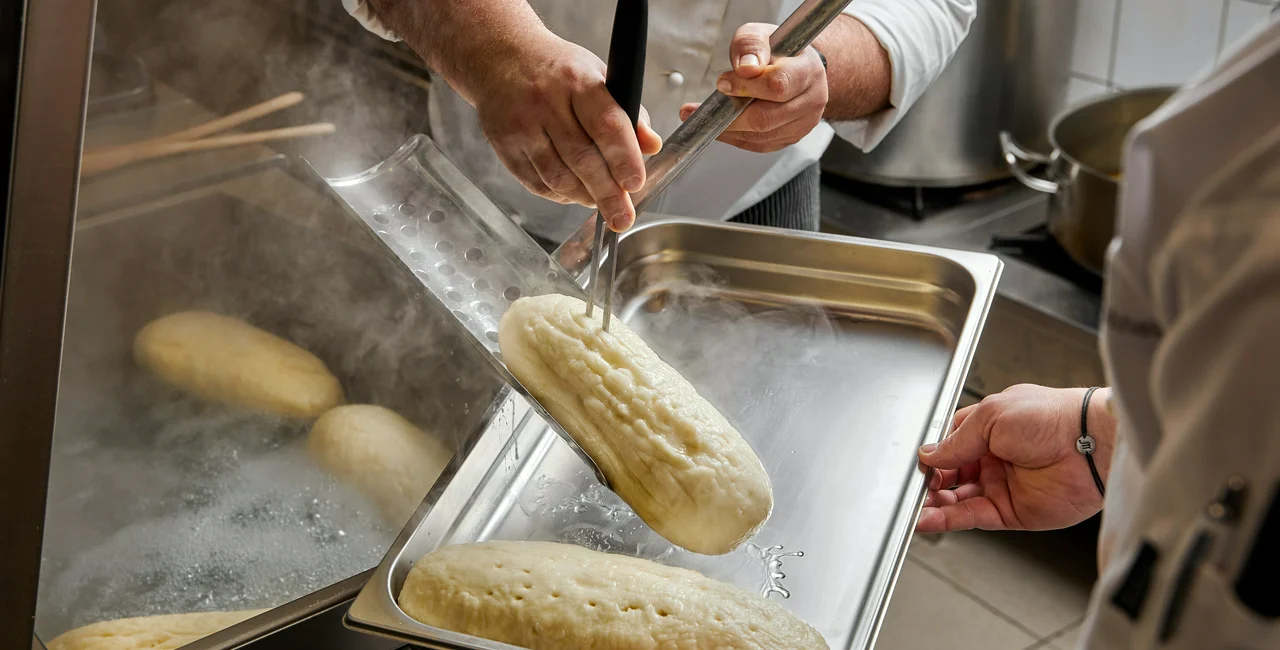The bread dumpling, made from houska, a Czech bun, is synonymous with Czech cuisine. Made from just a few simple ingredients, ensuring precision when working with them and following the right steps are key to success.
In Czechia, the bread dumpling is most often served with meat and sauce (tomato, dill, or horseradish are favorites). It’s a beloved side dish for goulash and an essential part of the quintessential Czech dish, pork and cabbage (vepřo knedlo zelo). Leftover dumplings can be cut into cubes and scrambled with eggs for a fast and filling meal that’s well-known to students on a budget.
Semi-finished bread dumplings are widely available in shops but their taste and texture don't compare to homemade dumplings by a mile. If you’re feeling a bit daunted by the idea of DIY dumplings, the chefs from Prague’s Lokál pub have some tips and tricks for making yours come out perfect every time.
Easy on the salt
Add your salt to the bowl first making sure it doesn't come into contact with the yeast. Salt slows the leavening power of the yeast and affects the rise. It’s also key to consider the final dish: dumplings are meant to play a supporting role to your flavorful sauce, not overpower it with saltiness.
Flour power for perfection
Bread dumpling requires coarsely ground flour (hrubá mouka), to ensure a perfectly leavened and fluffy dough. Flour at room temperature will promote proper rising.
Pay attention to temperature
The temperature of the milk also affects how the dumpling will rise and should be neither hot nor cold. Lokál chefs heat it to 40-50 degrees Celsius so that it remains lukewarm even after it has cooled in the bowl with flour, thus enhancing the effectiveness of the yeast. Our chefs advise pouring all the milk in at once as diluting the batter becomes quite difficult.
Use a better bread
Diced buns should be mixed in at the very end in order to achieve a smooth dough that doesn’t stick to the sides of the bowl. The bread must be dry and hard – fresh, soft bread will become soggy when kneaded and won’t give the dumpling the desired texture. It’s important to process the bread cubes briskly and gently; crushing your bread into crumbs is a big dumpling don’t!
A pinch of history|The oldest mentions of dumplings date back to Roman cookery and the Chinese Tang dynasty. At different points in history and in different places around the world, ancient dumplings were eaten as fried balls or baked and filled or rolled from a mixture of meat, fish, or legumes. Dumplings share in common the idea of trying to stretch out meat to feed a number of people. In the 17th century, plain flour was added to dumpling recipes creating the dumplings many cultures enjoy today. The popularity of Czech dumplings is attributed to Czech cookbook author Magdalena Dobromila Rettigová known for her groundbreaking 19th-century cookbook "A Household Cookery Book."
CHEF'S TIP: Instead of a classic houska, you can also use stale rohlík or toast bread. The baked, brown crust of these bread types creates a nice mosaic effect.
Triple-rise is a must
The dumpling needs time. The dough must be thoroughly mixed and kneaded to get rid of air bubbles and not crack during heating. In a lot of recipes, the dumpling is left to rise twice, but the chefs from Lokál swear by triple leavening, with the dough rising in a kneading bowl for 20-30 minutes after which it should increase in size by two-thirds.
The risen dough is then rolled out and shaped into a bun and left to rise, covered, on your worktop for 15 minutes (your counter space shouldn’t be too cold). Make sure when rolling out the dough that you tighten up the dumpling, using a technique similar to rolling out pizza dough. This kind of folding frees the dough from excess air and helps the gluten kick in. The dough needs to have the preliminary shape of a dumpling, otherwise, it falls during the third rise.
The last stage of rising requires a delicate touch. The dumpling is carefully rolled into a log, placed on its side and left to rest for approximately 10 minutes. Don’t touch! Disturbing the puffy surface of the dough will cause your dumpling to fall.
CHEF'S TIP: Cover the dumplings with a tea towel throughout the rising time. It absorbs moisture from the dough and can prevent the rolls from drying out and cracking during cooking.
Steaming vs. boiling
To boil or steam? It’s a matter of personal choice. Lokál chefs carefully place their dumplings in boiling salted water making sure they’d don’t bump into each other or change shape. Important: The water sholdn’t stop boiling at any point during the cooking process. After 8 minutes, dumplings are rotated 180 degrees, cooked for another eight minutes, and done.
Dumpling myth busted: When preparing a bread dumpling, Czech homecooks often say they’re ready "when they float to the surface". The leavened dough is still full of air, and it will carry it to the top right after the dumpling floats into the bubbling water. Let it sit for a minute before removing from the pot.
Once out of the pot, the steam must be released. Poke the bread dumpling with a fork immediately after cooking, ideally while it is still lying on the tray. Unevaporated water would cause the dough to curdle.
Czech bread dumplings (Houskový knedlík)
ingredients
Serves 8-10
- 8 g of salt
- 1 kg coarse flour (hruba mouka)
- 20 g of fresh yeast
- 1 egg
- 500 ml of milk
- approx. 4 buns (houska), cut into cubes
method
- 1.Add the salt and flour to a bowl, sprinkle with yeast, and crack in the eggs.
- 2.Pour in the warmed milk and mix (in a food processor) for 4-5 minutes until a smooth dough is formed.
- 3.Leave to rise in a warm place for 20-30 minutes. The dough will increase in volume by about two-thirds.
- 4.Transfer the dough to a clean workspace and divide it into three or four sections. Fold each piece several times and roll it into an oblong shape. Let rest for 15 minutes.
- 5.Form logs from the risen dough and wait 10 minutes for them to rise.
- 6.Place the logs into boiling salted water. After 8 minutes, turn them over and cook for another 8 minutes.
- 7.Pierce the cooked dumplings immediately with a fork and brush with butter.
TIPS: Hot dumplings are brushed with melted butter – or lard to soften and enhance with the taste and aroma of fat.
Cooled bread dumplings can be wrapped in foil and kept in the refrigerator for up to three days, the remaining slices can also be frozen.
In the Czech Kitchen is a weekly column written in cooperation with the culinary experts from Ambiente. Established in 1995, the Prague-based collective of pubs, restaurants, and fine-dining outlets has transformed the Czech culinary landscape and lent to the widespread awareness of quality food service and production in Czechia. Follow their socials or book your table at www.ambi.cz.












 Reading time: 5 minutes
Reading time: 5 minutes 


















